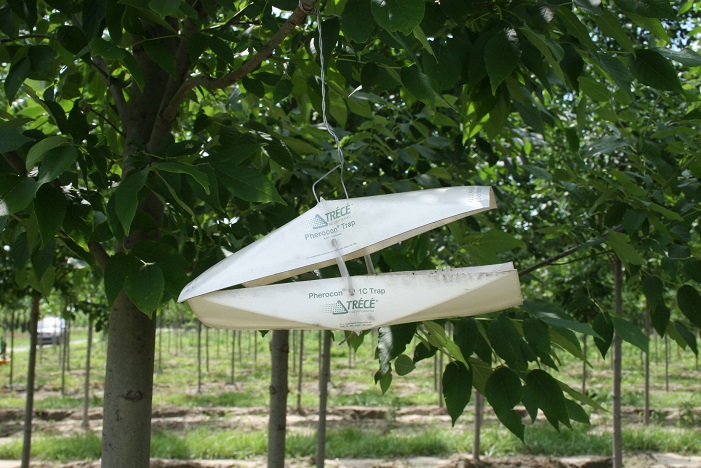–by Dr. Raymond Cloyd
The time of year has come to be thinking about dealing with the ash/lilac borer (Podosesia syringae). First, you need to understand that this is not the same insect pest as the Emerald ash borer (Agrilius planipennis), which was recently discovered (March 31, 2017) in Doniphan County (Kansas now has 7 counties under quarantine). Emerald ash borer is a wood-boring beetle whereas the ash/lilac borer is a wood-boring caterpillar. Ash/lilac borer adults are generally active from mid-April through early-May. Adults are brown, clearwing moths that resemble paper wasps (Figure 1). Peak moth activity commonly occurs from May through June; however, this depends on temperature. Adult females lay tan-colored, oval-shaped eggs in cracks and crevices, or wounds at the base of plant stems. A single female may live approximately one week and lay up to 400 eggs. Below are the major life history parameters and management strategies affiliated with the ash/lilac borer:
Figure 1. Ash Lilac Borer Adults Mating
* Larvae cause plant damage by creating tunnels and feeding within the bark (cambium). Moreover, larvae may bore further into the wood and feed within the sapwood and heartwood.
* Feeding by the larvae restricts the flow of water and nutrients causing shoot or branch dieback. Ash/lilac borer primarily feed near the base of plant stems creating swollen areas or cracks at the base of plants, and where major branches attach to the trunk.
* Evidence of larval feeding includes the presence of light-colored sawdust that accumulates at the base of infected trees or shrubs.
* Ash/lilac borer overwinters as a late-instar larva located in feeding tunnels or galleries.
* To determine if trees or shrubs are or have been infested with ash/lilac borers check for the presence of brown papery pupal cases that protrude from the bark (Figure 2). These are the pupal cases where adults emerged from.
* In Kansas, there is generally one generation per year.
Figure 2. Pupal Cases of Ash Lilac Borer Protruding From Tree Trunk
* The way to avoid problems with ash/lilac borer is to minimize “plant stress” by properly implementing cultural practices, such as; irrigation (watering), fertility, pruning, and mulching. Stressed plants are more susceptible to attack than so called “healthy plants.” A two to three foot wide mulched area around the base of trees and shrubs prevents injury from lawn mowers and weed-trimmers. In addition, avoid pruning plants in late spring through early summer (under usual weather conditions), because this is when adults are typically present and the volatiles emitted from pruning cuts may attract adult females.
* Insecticides containing the active ingredients, permethrin or bifenthrin can be applied to the bark, at least up to six feet from the base, in order to prevent ash/lilac borer larvae from entering plants after eggs hatch. Clear-wing borer larvae crawl on the bark searching for entry points, which exposes them to insecticide residues.
* Pheromone traps are commercially available for capturing adult males (Figure 3), which helps to determine when females will be laying eggs. Pheromone traps help in timing insecticide applications. Insecticide spray applications should begin seven to10 days after capturing the first adults. Be sure to also check pheromone traps two to three times per week and record the number of newly captured adult males.
Figure 3. Pheromone Trap Used To Capture Ash Lilac Borer Adult Males
* For more information regarding ash/lilac borer management contact your county or state extension specialist.


